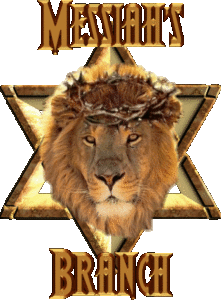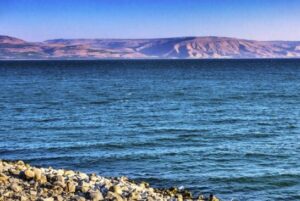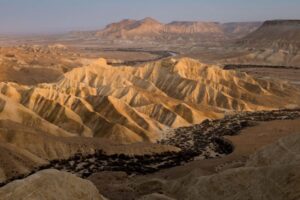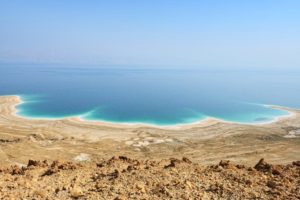Rarest, Significant Hebrew Words – Virtually Hidden
Two virtually hidden Hebrew words appear only three times in the Hebrew text of the Tanakh, the Old Testament. Quit possibly they are the most significant words in the Bible.
Written as Hmleh, hmle and hā-‘al-māh, the Hebrew text is comprised of two words, ha and `almah.[1] Only two English Bible versions translate from Hebrew all three instances of ha-almah as “the virgin” – the Orthodox Jewish Bible and Young’s Literal Translation.[2]
Represented by the single English consonant letter h or words Hey or ha translated as “the,” it is a definite article used to make a clear and specific reference.[3] Hebrew has a special difference where, by definition, it is much more dramatic.[4] Hebrew language expert Jeff A. Benner describes the original pictograph character in this way:[5]
“The Hey has a “h” sound and is a picture of a man with his arms raised up, shouting and pointing at a great site as if to say “behold, look at that”. This letter means “the” in the sense of pointing to something of importance.”[6]
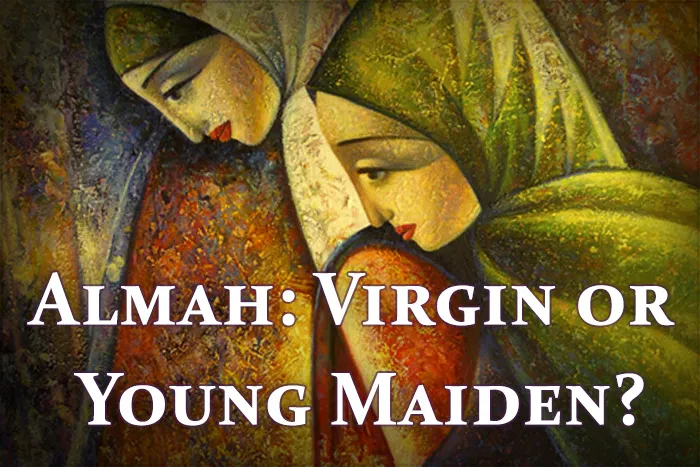 Translation of `almah is one of the most controversial in the Jewish and Christian Bibles. One side claims `almah means “young woman” which may or may not include a state of virginity.[7] On the opposite side, the assertion is that `almah specifically means “virgin” as seen in some Christian Bible translations.[8]
Translation of `almah is one of the most controversial in the Jewish and Christian Bibles. One side claims `almah means “young woman” which may or may not include a state of virginity.[7] On the opposite side, the assertion is that `almah specifically means “virgin” as seen in some Christian Bible translations.[8]
Strong’s Concordance of Hebrew defines `almah is “a lass (as in veiled or private): – damsel, maid, virgin.”[9] In that era, a “maid” or “damsel” was typically presumed to be a virgin by implication of her young age and single marital status whereas the word “virgin” is explicitly self-explanatory.[10]
Exacerbating the controversy, the words “young woman” are not part of the formal Strong’s definition. Key to unraveling the differences is through textual analysis to determine how the word is intended to be understood by its authors.
Lowest common denominator is the word is na`arah meaning “girl” or “young woman” where there is no specific implication of virginity. Isaiah never once used this word.
Hebrew text is the word bethulah (bə-ṯū-lāh, bthuwlah, b@thuwlah or hlwtb), a single word for “virgin.”[11] Only when the word is used in combination with na ‘arah, a girl, is the word used to describe the virginity of an actual female subject; otherwise, the word is used unaccompanied in the contexts of metaphors in judgements of peoples or nations; lamentations or blessings; or legalistic references.
Focusing only on Biblical references where bethulah involves an actual female subject, three usage rules emerge. Bethulah is never used as the subject who initiates a present or future action such as a prophecy. For example, there are no instances that say something like “bethulah shall call;” “bethulah plays;” “bethulah shall bear;” nor “bethulah loves.”[12]
Secondly, the word is always used to clarify the noun na `arah (girl) or another female noun either as an adjective noun or in an adjective clause within the context of na `arah. Examples: “the girl [na `arah] was a very beautiful virgin [bethulah];” “Tamar [proper noun], for she was a virgin [bethulah];” or “my virgin [bethulah] daughter [noun].”[13]
Most significantly, bethulah is never used as a standalone noun to describe a specific female subject in Biblical texts. Some critics contend that since bethulah was not used in Isaiah 7:14, the prophecy cannot refer to a virgin even though using the word would violate all three Hebrew text usage rules.[14]
Only 7 times in Biblical Hebrew texts appears the word `almah and its word usage rules are strikingly different from bethulah. Translation of `almah is based as much on the circumstantial setting as it is on sentence structure.
As the direct female subject of a sentence, `almah appears only in present or future tense scenarios. Biblical examples: “`almah playing tambourines;” “`almah went and called;” “`almah love you;” “`almah comes out to draw water,” and “almah shall conceive and bear a Son.”[15]
Conversely, `almah is never used as an adjective noun nor used in an adjective clause to define the female subject; it is a standalone noun. No instances say, for example, “a na `arah who is an `almah;” “Tamar who is an `almah;” nor “my `almah daughter.”
As a standalone noun, `almah does not need further clarification with an adjective or adjective clause – the meaning of `almah is self-evident to mean “virgin.” (literary analysis)
Five instances of `almah occur in texts after the defining event when the Law was given by God to Moses at Mt. Sinai. Perhaps most revealing is that they always appear in royal circumstances: virgins in the king’s harem, in a king’s presence, a king’s perspective, and the royalty of God’s musical worship.[16]
Only three instances appear in Hebrew texts where ha (“pointing to something of importance”) is added as a prefix to `almah, in essence saying, “behold, look at the almah.” Two of the occurrences are used in reference to Hebrew matrons before God’s Law legally defined the purity of virginity for marriage.[17]
Rebekah and Miriam are Hebrew matriarchs, according to Phillip E. Goble, Editor of The Orthodox Jewish Bible. Rebekah is revered as the “mother of the Nation of Israel” and Miriam is “the savior of the Exodus” (older sister of Moses) – Hebrew royalty.[18] Significance of their state of virginity occurs before entering their adult lives of greatness.[19]
Only one other appearance of ha-almah occurs in the entire Bible and it appears after the Law was handed down from God: Isaiah 7:14. Written identically in Hebrew in both The Great Isaiah Scroll and the Masoretic text:[20]
IS 7:14 “Therefore the Lord himself will give you a sign: The virgin will conceive and give birth to a son, and will call him Immanuel.“(NIV)
Isaiah 7:14 has a dual application of royalty – King Ahaz and God. In the prophecy, the use of the words ha-almah places the subject female in the highest echelon of Jewish importance.
From a different perspective, if the prophetic sign of Isaiah 7:14 was intended to refer to a female without an expectation of virginity, textual analysis dictates Isaiah would have been expected to use either na ‘arah or `ishshah; however, he didn’t. Instead, Isaiah used the rarest of Hebrew words to prophecy ha-almah would give birth to a son to be called Immanuel meaning “God with us.”[21]
King Ahaz had refused to accept God’s offer through Isaiah to name any sign between Heaven and Hell as proof of God’s promise to protect his kingdom from their enemies. God responded with a sign that was even greater – anything less would be unimpressive.
Is Isaiah 7:14 a prophecy about a virgin, greater than any between Heaven and Hell, that was fulfilled by Mary’s virgin birth of Jesus of Nazareth?
Updated December 18, 2023.
This work is licensed under a Creative Commons Attribution-NonCommercial-NoDerivatives 4.0 International License.
ASB = Amercian Standard Bible
BSB = Berean Study Bible
CSB = Christian Standard Bible
DBT = Darby Bible Translations
ESV = English Standard Version
HCS = Holman Christian Standard Bible
ISV = International Standard Version
JUB = Jubilee Bible 2000
NHE = New Heart Christian Bible
NIV = New International Verson
NKJV = New King James Verson
NLT = New Liviing Translation
OJB = Orthodox Jewish Bible
WEB = World English Bible
YLT = Young’s Literal Translation
REFERENCES:
[1] Isaiah 7:14. Hebrew text transliteration. BibleHub. 2019. <https://biblehub.com/text/isaiah/7-14.htm> hā·‘al·māh. Hebrew text. BibleHub.com. n.d. <https://biblehub.com/hebrew/haalmah_5959.htm>
[2] The Orthodox Jewish Bible. 2002. BibleHub. <https://biblehub.com/ojb/genesis/1.htm Young’s Literal Translation. 2019. <https://biblehub.com/ylt/genesis/1.htm>
[3] Isaiah 7:14. Hebrew text. NetBible.org. <http://classic.net.bible.org/verse.php?book=Isa&chapter=7&verse=14> ‘almah <05959>. NetBible.org. 2019. <http://classic.net.bible.org/strong.php?id=05959> “the.” Merriam-Webster. 2019. <https://www.merriam-webster.com/dictionary/the> “the.” Cambridge Dictionary. n.d. <https://dictionary.cambridge.org/dictionary/english/the
[4] Goble, Phillip E, ed. “The Translator to the Reader.” The Orthodox Jewish Bible. 2002. Artists for Israel International. 2012. p vii. <http://www.afii.org/ojbible/ix.pdf
[5] Benner, Jeff A. “Introduction to Ancient Hebrew.” Ancient Hebrew Research Center. 2019. <https://www.ancient-hebrew.org/introduction.htm>
[6] Benner. “Introduction to Ancient Hebrew.”
[7] Nahigian, Kenneth E. “A Virgin-Birth Prophesy?” Skeptic Tank Files. n.d.<http://www.skeptictank.org/files/sr/2virgi93.htm> Cramer, Robert Nguyen. “The Book of Isaiah.” The BibleTexts.com. 1998 <http://www.bibletexts.com/verses/v-isa.htm> Cline, Austin. “Who Was Virgin Mary, Mother of Jesus? Was She Really a Virgin?” About.com|Agnosticism/Atheism. n.d. <http://atheism.about.com/od/biblepeoplenewtestament/p/MaryVirgin.htm> Yosef, Uri. “Isaiah 7:14 – Part 1: An Accurate Grammatical Analysis.” The Jewish Home. 2011. <http://thejewishhome.org/counter/Isa714_1.pdf>> Bratcher, Dennis. The Voice. “Isaiah 7:14: Translation Issues.” 2014. <http://www.crivoice.org/isa7-14.html> The Complete Jewish Bible with Rashi Commentary. n.d. <http://www.chabad.org/library/bible_cdo/aid/63255/jewish/The-Bible-with-Rashi.htm> CR Judges Chapter 13. John Gill’s Exposition of the Whole Bible. Isaiah 7:14 commentary. <https://www.studylight.org/commentaries/geb/genesis-24.html
[8] Genesis 24:43 – ESV, NKJV, KJV, HCS, OJB; Exodus 2:8 – OJB; Isaiah 7:14 – NIV, NLT, ESV, BSB, NKJV, CSB, HCS, DBT, ISV, JUB, NHE, WEB, OJB; American Standard Version, 1901 Edition. Perseus.Tufts.Edu. <http://www.perseus.tufts.edu/hopper/text?doc=Perseus:text:1999.01.0156:book=Isaiah:chapter=7&highlight=virgin> Robinson, B.A. “Isaiah 7:14 “Behold, a virgin shall conceive…”” Religious Tolerance. 2007 <http://www.religioustolerance.org/chr_proi.htm
[9] “almah.” Strong’s Concordance with Hebrew and Greek Lexicon. Eliyah.com. n.d. <http://www.eliyah.com/cgi-bin/strongs.cgi?file=hebrewlexicon&isindex=almah
[10] Net.bible.org. Hebrew text. Reference: TWOT – 1630b. Strong. “`almah <5959> “damsel.” Merriam-Webster. 2019. <https://www.merriam-webster.com/dictionary/damsel> “na`arah <05291>” NetBible.org. 2019. <http://classic.net.bible.org/strong.php?id=05291> Mishneh Torah, Forbidden Intercourse 17.” Sefaria.org. Footnotes #48 & 49. n.d. <https://www.sefaria.org/Mishneh_Torah%2C_Forbidden_Intercourse.17.13?lang=bi&with=Navigation&lang2=en>
[11] “bthuwlah.” Strong’s Concordance with Hebrew and Greek Lexicon. Eliyah.com. n.d. <http://www.eliyah.com/cgi-bin/strongs.cgi?file=hebrewlexicon&isindex=bthuwlah>> Strong The New Strong’s Exhaustive Concordance of the Bible. “ bethulah <1330>.” <http://classic.net.bible.org/strong.php?id=01330> Genesis 24:16. Net.bible.org. Hebrew text. “b@thuwlah <01330>;” footnote 1. <http://classic.net.bible.org/verse.php?book=Gen&chapter=24&verse=16
[12] CR Isaiah 7:14; Psalms 68:25; Song of Solomon 1:3.
[13] Genesis 24:16, 2 Samuel 13:2. Soncino Babylonian Talmud. Ed. Isidore Epstein 1935-1948. Yebamoth 61b. Soncino Babylonian Talmud. <https://israelect.com/Come-and-Hear/yebamoth/yebamoth_61.html> CR 2 Samuel 13:18; I Kings 1:2. “na`arah <05291>” NetBible.org. 2019. <http://classic.net.bible.org/strong.php?id=05291>
[14] Nahigian. “A Virgin-Birth Prophesy?” Cramer. “The Book of Isaiah.” Cline. “Who Was Virgin Mary, Mother of Jesus? Was She Really a Virgin?” Yosef.. “Isaiah 7:14 – Part 1: An Accurate Grammatical Analysis.” Bratcher. “Isaiah 7:14: Translation Issues.”
[15] CR Genesis 24:16; Psalms 68:25; Song of Solomon 1:3, 6:8; Isaiah 7:14.
[16] CR Psalms 68:25; Proverbs 30:19; Song of Solomon 1:3, 6:8; Isaiah 7:14.
[17] Genesis 24:43; Exodus 2:8.
[18] Goble. “The Translator to the Reader.” p vii.Goble. “The Translator to the Reader.” p vii. Net.bible.org. Hebrew text. “`almah <5959>” <http://classic.net.bible.org/strong.php?id=05959> Strong. The New Strong’s Exhaustive Concordance of the Bible. “almah.”
[19] Goble. “The Translator to the Reader.” p vii.
[20] Miller. Fred P. “The Translation of the Great Isaiah Scroll.” Book of Isaiah. 2001. Column VI Isa 6:7 to 7:15. <http://www.moellerhaus.com/qa-tran.htm “hmleh.” Net.bible.org. <http://classic.net.bible.org/search.php?search=hebrew_strict_index:hmleh> BibleHub.com. Interlinear Bible Hebrew text. Isaiah 7:14. “5959 [e] hā·‘al·māh”.< http://biblehub.com/interlinear/isaiah/7-14.htmOrthodox Jewish Bible (OJB). Isaiah 7:14.
[21] “`Immanuw’el <06005>. NetBible.org. 2019. <http://classic.net.bible.org/strong.php?id=06005> Isaiah 7.14. BibleHub.com. Strong’s Lexicon. “Immanuel.” <https://biblehub.com/parallel/isaiah/7-14.htm

